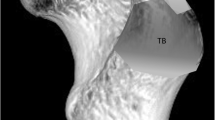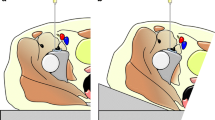Abstract
Objective
To describe a lateral fluoroscopically guided retrocalcaneal bursa injection technique, report patient outcomes at 1–4 weeks after steroid/anesthetic retrocalcaneal bursal therapeutic injection, and correlate pre-injection diagnostic heel ultrasound variables with improvement in patient pain scores.
Materials and methods
After IRB approval, fluoroscopically guided therapeutic retrocalcaneal bursa injections performed using a lateral approach were retrospectively reviewed. Pre-injection heel ultrasound results and pre- and post-injection patient VAS pain scores (scale 0–10) were recorded. The Wilcox matched-pair test compared pain scores, and Spearman’s rho assessed for correlation between pain score changes and heel ultrasound results.
Results
Thirty-two injections were performed in 30 patients (25 females, 5 males; mean 56.5 ± 9.3 years, range 39–75 years; 21 left heel, 11 right heel) with technical success in 32 of 32 cases (100 %). Insertional Achilles tendon pathology and retrocalcaneal bursitis were present in 31 of 32 cases (97 %) and 16 of 32 cases (50 %), respectively. Median pre- and post-procedure pain scores were 8 (IQR 7, 10) and 1.75 (IQR 0, 6). A statistically significant decrease in pain score was observed following injection, with a median change of 4.75 (IQR 3, 8; p < 0.001). Clinically significant response (>50 % reduction in pain score) was present in 69 % (95 % CI, 0.52–0.86; p < 0.001). No significant correlation was identified between a decrease in pain score and a sonographically abnormal Achilles tendon or retrocalcaneal bursa.
Conclusion
Fluoroscopically guided retrocalcaneal bursal steroid/anesthetic using a lateral approach is an effective technique. This technique yielded 100 % technical success and a clinically significant decrease in patient pain scores (p < 0.001).



Similar content being viewed by others
References
Uquillas CA, Guss MS, Ryan DJ, Jazrawi LM, Strauss EJ. Everything Achilles: knowledge update and current concepts in management. J Bone Joint Surg Am. 2015;97(14):1187–95.
Wijesekera NT, Chew NS, Lee JC, et al. Ultrasound-guided treatments for chronic Achilles tendinopathy: an update and current status. Skelet Radiol. 2010;39:425–34.
Schepsis AA, Jones H, Haas AL. Achilles tendon disorders in athletes. Am J Sports Med. 2002;30(2):287–305.
Nazarian LN, Rawool NM, Martin CE, Schweitzer ME. Synovial fluid in the hindfoot and ankle: detection of amount and distribution with US. Radiology. 1995;197(1):275–8.
Pang BS, Ying M. Sonographic measurement of achilles tendons in asymptomatic subjects: variation with age, body height, and dominance of ankle. J Ultrasound Med. 2006;25(10):1291–6.
Leung JL, Griffith JF. Sonography of chronic Achilles tendinopathy: a case-control study. J Clin Ultrasound. 2008;36(1):27–32.
Metcalfe D, Achten J, Costa M. Glucocotricosteroid injections in lesions of the Achilles tendon. Foot Ankle Int. 2009;30(7):661–5.
Asplund C, Best TM. Achilles tendon disorders. BMJ. 2013;346:f1262.
Hugate R, Pennypacker J, Saunders M, Juliano P. The effects of intratendinous and retrocalcaneal intrabursal injections of corticosteroid on the biomechanical properties of rabbit Achilles tendons. J Bone Joint Surg. 2004;86A:794–801.
Turmo-Garuz A, Rodas G, Balius R, et al. Can local corticosteroid injection in the retrocalcaneal bursa lead to rupture of the Achilles tendon and the medial head of the gastrocnemius muscle? Musculoskelet Surg. 2014;98:121–6.
Kachlik D, Baca V, Cepelik M, et al. Clinical anatomy of the retrocalcaneal bursa. Surg Radiol Anat. 2008;30:347–53.
Author information
Authors and Affiliations
Corresponding author
Ethics declarations
Conflict of interest
The authors declare that they have no conflict of interest.
Rights and permissions
About this article
Cite this article
Goldberg-Stein, S., Berko, N., Thornhill, B. et al. Fluoroscopically guided retrocalcaneal bursa steroid injection: description of the technique and pilot study of short-term patient outcomes. Skeletal Radiol 45, 1107–1112 (2016). https://doi.org/10.1007/s00256-016-2368-9
Received:
Revised:
Accepted:
Published:
Issue Date:
DOI: https://doi.org/10.1007/s00256-016-2368-9




